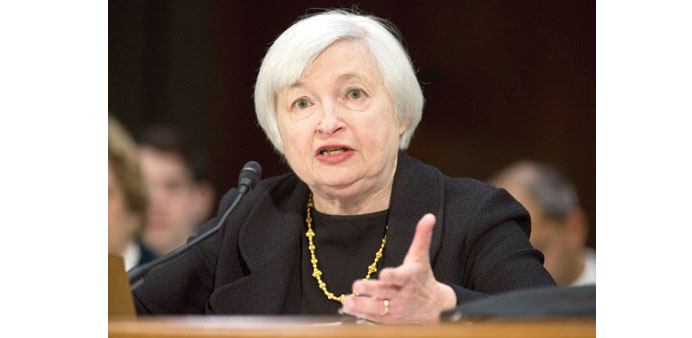AFP
The US Federal Reserve began a two-day policy meeting yesterday under rising pressure to step off its ultra-dovish stance to address rising inflation and worries of overheated markets.
So far this year the Fed has stuck to its plan: steadily reducing its bond-buying stimulus program, to wind up in October, and looking toward an initial increase in the benchmark federal funds interest rate, now at zero, in the second half of 2015.
But increasingly analysts and some Fed officials are saying that rate adjustment needs to begin early next year, and are calling for Fed Chair Janet Yellen to signal a less dovish stance in the Federal Open Market Committee’s (FOMC) policy statement today.
Richard Fisher, the hawkish head of the Federal Reserve’s Dallas branch, said in a newspaper opinion article on Sunday that the country is experiencing “financial excess that is of our own making.”
He warned that Yellen’s plans to use broader economic and financial system supervision to protect against bubbles is not enough and is providing “an artificial sense of confidence.”
Fed watchers generally do not expect the FOMC to announce any shift to the policy trajectory in Wednesday’s statement.
“We are not anticipating any major new signal from the FOMC statement yet,” said Jim O’Sullivan at High Frequency Economics.
But the rising clamor for the Fed to pay attention to how money is flowing into increasingly risky assets, like low-grade corporate debt and higher-risk stocks, could shape the policy discussion.
Beyond the repeated stock market records and other suggestions of asset bubbles is economic data that has been mostly positive for the past three months, after the sharp contraction of the first quarter.
In June the economy pumped out a much better-than-expected 288,000 net new jobs, capping the best half-year for the employment market since 2007.
That pulled the unemployment rate down to 6.1%, a level that the Fed thought in March would only be reached by year-end.
Although slower than last year, the housing sector continues to grow, and prices are still rising. Consumer confidence has surged to its highest level in nearly seven years.
Inflation data shows strength in the economy as well. In June the consumer price index was up 2.1% year-on-year, the same as the previous month, and 1.9% if volatile food and energy prices are stripped out.
That puts inflation around the level the Fed has been targeting with its efforts to stimulate the economy.
Yellen has consistently stressed that the Fed can adjust its policy when the data turns more positive or negative than anticipated. But she also stresses the need to be sure that gains in growth and job creation are sustainable.
She has often highlighted downside risks to the improved picture: the turmoil in the Middle East and Eastern Europe; China’s weakening economy; still-high US long-term unemployment and a low participation rate in the jobs market; and more broadly the question of how fast the economy will rebound from the first-quarter slump.
Taking a similarly cautious view, the International Monetary Fund last week cut its forecast for US economic growth this year to 1.7%, slower than in 2013.



